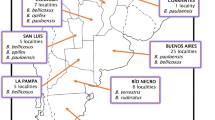Abstract
Intra- and interspecific larval interactions that take place in a host body were investigated for two tachnid fliesEpicampocera succincta andCompsilura concinnata (Diptera: Tachinidae) parasitizingPieris butterfly larvae.E. succincta, a specialist onPieris butterflies, showed contest-type intraspecific competition, eliminating all the other conspecific larvae. On the other hand, an extreme generalist parasitoidC. concinnata exhibited scramble-type competition, sharing the host with other conspecifics and suffering reduced body size as a result. However, when these two species occurred together in a single host,C. concinnata had a much higher chance of survival. Moreover,C. concinnata could often survive in the presence of a parasitoid waspCotesia glomerata (Hymenoptera: Braconidae) whileE. succincta could not. The high tolerance ofC. concinnata could be attributable to its being an extreme generalist: To attack and survive on many different hosts, one has to be able to deal with various competitors. The competitive inferiority of the specialistE. succincta, on the other hand, may be a result of relatively recent encounter with, those competitors.
Similar content being viewed by others
References
Arnaud, P. H. (1978) A host-parasite catalog of North American Tachinidae (Diptera).U.S.D.A. Miscellaneous Publication 1319: 1–860.
Askew, R. R. (1994) Parasitoids of leaf-mining Lepidoptera: what determines their host ranges? pp. 177–202.In B. A. Hawkins and W. Sheehan (eds.)Parasitoid community ecology. Oxford University Press, Oxford.
Askew, R. R. and M. R. Shaw (1986) Parasitoid communities: their size, structure and development. pp. 225–264.In J. Waage and D. Greathead (eds.)Insect parasitoids., Academic Press, London.
Bernays, E. A. and R. F. Chapman (1994)Host-plant selection by phytophagous insects. Chapman & Hall, New York.
Bisset, G. A. (1938) Larvae and pupae of tachinids parasitizingPieris rapae L. andP. brassicae L.Parasitology 30: 111–122.
Culver, J. J. (1919) A study ofCompsilura concinnata, an imported tachinid parasite of the gipsy moth and the brown-tail moth.USDA Bulletin 766: 1–27.
Dempster, J. P. (1967) The control ofPieris rapae with DDT. 1. The natural mortality of the young stages ofPieris.Journal of Applied Ecology 4: 485–500.
Dowden, P. B. (1933)Lydella nigripes andL. piniariae, fly parasites of certain tree-defoliating caterpillars.Journal of Agricultural Research 46: 963–995.
Evans, E. W. (1982) Timing of reproduction by predatory stinkbugs (Hemiptera: Pentatomidae): patterns and consequences for a generalist and a specialist.Ecology 63: 147–158.
Fisher, R. C. (1963) Oxygen requirements and the physiological suppression of supernumerary insect parasitoids.Journal of Experimental Biology 40: 531–540.
Futuyma, D. J. and T. E. Philippi (1987) Genetic variation and covariation in responses to host plants byAlsophila pometaria (Lepidoptera: Geometridae).Evolution 41: 269–279.
Futuyma, D. J. and S. S. Wasserman (1981) Food plant specialization and feeding efficiency in the tent caterpillarsMalacosoma disstria andM. americanum.Entomologia Experimentalis et Applicata 30: 106–110.
Iwao, K., Y. Sato and N. Ohsaki (1989) Spatio-temporal distribution patterns of two tachinid flies,Epicampocera succincta andCompsilura concinnata parasitizingPieris.Researches on Population Ecology 31: 105–112.
MacArthur, R. H. (1972)Geographical ecology. Harper & Row, New York.
Matsuzawa, H. (1958) Ecological studies on the braconid wasp,Apanteles glomeratus.Memoirs of Faculty of Agriculture, Kagawa University 3: 1–125.
Ohsaki, N. (1982) Comparative population studies of threePieris butterflies,P. rapae, P. melete andP. napi, living in the same area. III. Difference in the annual generation numbers in relation to habitat selection by adults.Researches on Population Ecology 24: 193–210.
Ohsaki, N. and Y. Sato (1990) Avoidance, mechanisms of threePieris butterfly species against the parasitoid waspApanteles glomeratus.Ecological Entomology 15: 169–176.
Ohsaki, N. and Y. Sato (1994) Food plant choice ofPieris butterflies as a trade-off between parasitoid avoidance and quality of plants.Ecology 75: 59–68.
Partridge, L. and P. Green (1987) An advantage for specialist feeding in jackdaws,Corvus monedula.Animal Behavior 35: 982–990.
Rausher, M. D. (1984) Tradeoffs in performance on different hosts: evidence from within- and between-site variation in the beetleDeloyala guttata.Evolution 38: 582–595.
Richards, O. W. (1940) The biology of the small white butterfly (Pieris rapae), with special reference to the factors controlling its abundance.Journal of Animal Ecology 9: 243–288.
Salt, G. (1961) Competition among insect parasitoids.Symposium of the Society for Experimental Biology 15: 96–119.
Sato, Y. (1976) Experimental studies on parasitization byApanteles glomeratus L. (Hymenoptera: Braconidae). I. Parasitization of different species of genusPieris.Applied Entomology and Zoology 11: 165–175.
Scriber, J. M. and P. Feeny (1979) Growth of herbivorous caterpillars in relation to feeding specialization and to the growth form of their food plants.Ecology 60: 829–850.
Shaw, M. R. (1994) Parasitoid host ranges. pp. 111–144.In B. A. Hawkins and W. Sheehan (eds.)Parasitoid community ecology. Oxford University Press, Oxford.
Shima, H. (1973) New host records of Japanese Tachinidae (Diptera: Calyptrata).Sieboldia 4: 153–160.
Strickler, K. (1979) Specialization and foraging efficiency of solitary bees.Ecology 60: 998–1009.
Weseloh, R. M. (1983) Effects of multiple parasitism on the gypsy moth parasitesApanteles melanoscelus (Hymenoptera: Braconidae) andCompsilura concinnata (Diptera: Tachinidae).Environmental Entomology 12: 599–602.
Yasumatsu, K. and C. Watanabe (1964)A tentative catalogue of insect natural enemies of injurious insects in Japan. Part 1. Parasitepredator host catalogue. Entomology Lab., Faculty of Agriculture, Kyushu University, Fukuoka.
Author information
Authors and Affiliations
Rights and permissions
About this article
Cite this article
Iwao, K., Ohsaki, N. Inter- and intraspecific interactions among larvae of specialist and generalist parasitoids. Res Popul Ecol 38, 265–273 (1996). https://doi.org/10.1007/BF02515736
Received:
Accepted:
Issue Date:
DOI: https://doi.org/10.1007/BF02515736




